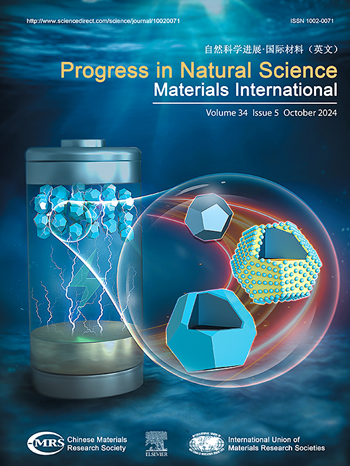Machine learning-assisted optimization of element ratios in high-entropy alloys for hydrogen evolution reaction
IF 7.1
2区 材料科学
Q2 MATERIALS SCIENCE, MULTIDISCIPLINARY
Progress in Natural Science: Materials International
Pub Date : 2025-06-01
DOI:10.1016/j.pnsc.2025.05.001
引用次数: 0
Abstract
As high-entropy alloys (HEAs) are widely applied in energy conversion and catalysis, efficiently and accurately designing HEAs with excellent catalytic performance has become a key challenge in research. Traditional HEAs design methods rely mainly on experience and extensive experiments, which are low in efficiency and high in cost. To overcome these challenges, density functional theory (DFT) calculations and machine learning (ML) methods have gradually been applied to the performance prediction and design of HEAs. We propose the “Differentiated Feature” method to train high-precision Light Gradient Boosting Machine (LGBM) models to predict the catalytic performance of FeaCobNicCudMoe HEAs (0.18 < a, b, c, d, e < 0.23, a+b + c + d + e = 1) in the hydrogen evolution reaction (HER). By combining DFT calculation results with machine learning models, we successfully identify Fe0.222Co0.185Ni0.185Cu0.203Mo0.203 HEAs with the best HER performance. Comparing the prediction results with experimental and DFT calculation data further validates the effectiveness of this method in predicting HER performance. This study provides new insights into the design of HEAs and accelerates the development of high-performance HEAs.

机器学习辅助下的高熵合金析氢反应元素比优化
随着高熵合金在能量转化和催化领域的广泛应用,高效、准确地设计具有优异催化性能的高熵合金已成为研究的关键课题。传统的HEAs设计方法主要依靠经验和大量的实验,效率低,成本高。为了克服这些挑战,密度泛函理论(DFT)计算和机器学习(ML)方法已逐渐应用于HEAs的性能预测和设计。我们提出了“差分特征”方法来训练高精度的光梯度增强机(LGBM)模型来预测FeaCobNicCudMoe HEAs (0.18 <;a, b, c, d, e <;0.23, a+b + c + d + e = 1)的析氢反应(HER)。将DFT计算结果与机器学习模型相结合,成功识别出HER性能最佳的Fe0.222Co0.185Ni0.185Cu0.203Mo0.203 HEAs。将预测结果与实验数据和DFT计算数据进行比较,进一步验证了该方法预测HER性能的有效性。该研究为高性能HEAs的设计提供了新的思路,加速了高性能HEAs的发展。
本文章由计算机程序翻译,如有差异,请以英文原文为准。
求助全文
约1分钟内获得全文
求助全文
来源期刊
CiteScore
8.60
自引率
2.10%
发文量
2812
审稿时长
49 days
期刊介绍:
Progress in Natural Science: Materials International provides scientists and engineers throughout the world with a central vehicle for the exchange and dissemination of basic theoretical studies and applied research of advanced materials. The emphasis is placed on original research, both analytical and experimental, which is of permanent interest to engineers and scientists, covering all aspects of new materials and technologies, such as, energy and environmental materials; advanced structural materials; advanced transportation materials, functional and electronic materials; nano-scale and amorphous materials; health and biological materials; materials modeling and simulation; materials characterization; and so on. The latest research achievements and innovative papers in basic theoretical studies and applied research of material science will be carefully selected and promptly reported. Thus, the aim of this Journal is to serve the global materials science and technology community with the latest research findings.
As a service to readers, an international bibliography of recent publications in advanced materials is published bimonthly.

 求助内容:
求助内容: 应助结果提醒方式:
应助结果提醒方式:


